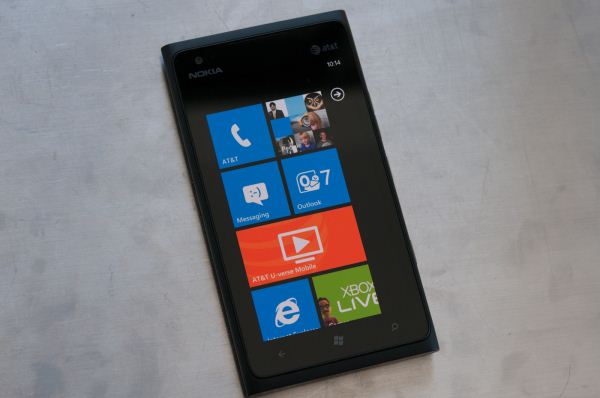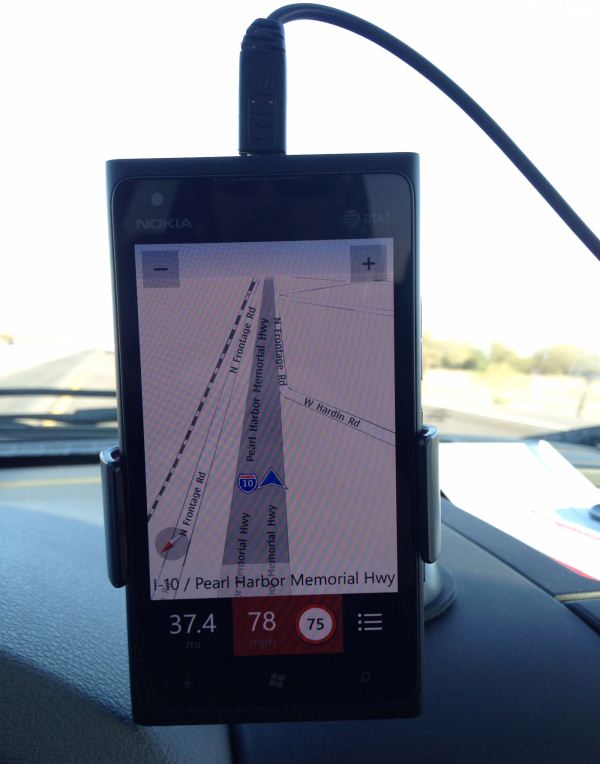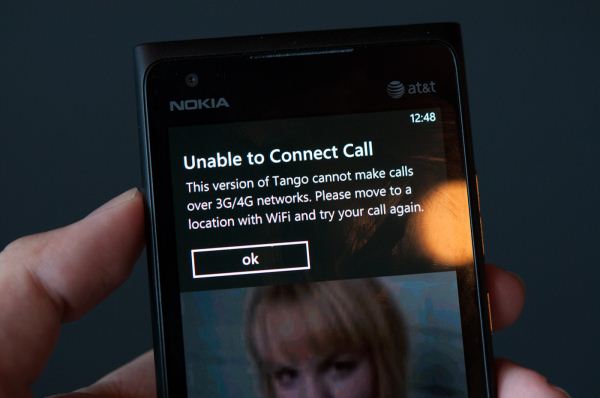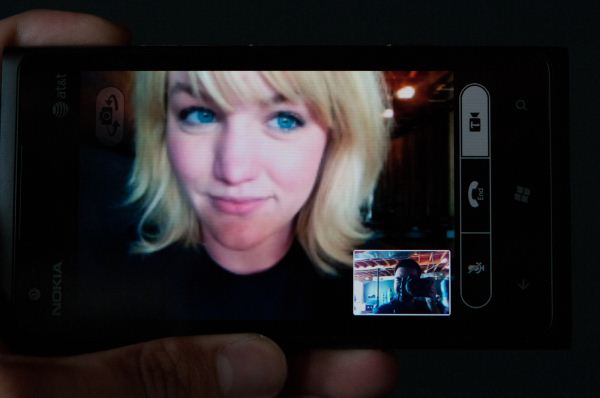Nokia Lumia 900 Review - Windows Phone with LTE
by Brian Klug on April 3, 2012 9:00 PM ESTWP7.5 and Preloaded Applications
To accommodate the Lumia 900’s unique inclusion of LTE, the device runs a newer build of WP7.5 Mango than I’ve seen on any other devices. Our sampled Lumia 900 came running 7.10.8112.7. Superficially I can’t find anything major which deviates from the WP7.5 I’ve seen on numerous other devices, other than again small changes to accommodate LTE. These boil down to inclusion of an LTE status indicator and an according change to the cellular settings page to select between EDGE / WCDMA (3G) / LTE (4G) - more on this later. We’ve gone over Windows Phone 7.5 Mango before, and what’s shipped on the Lumia 900 isn’t different from what has come before, obviously. Nokia’s input into the WP7.5 UI seems to go as far as their customized ringtones, a “Nokia Blue” theme, and the usual customization options for OEMs such as the right options under camera, marketplace link, and so forth.
As with any carrier-subsidized phone, there’s some software preload on the Lumia 900. The stuff that comes preinstalled on the Lumia 900 matches what I’ve seen on other AT&T-branded WP7 devices, namely AT&T Code Scanner, Navigator, Radio, U-Verse Mobile, an ESPN app, and YPmobile seem to be the bloat. What’s great about WP7 is that you can uninstall any of these preloaded applications and never have to see them again.
Oddly enough the only Nokia software among the preloads is the Nokia App Highlights application. The Marketplace includes a Nokia Collection shortcut as you’d expect, but there’s no preloaded Nokia Drive or Maps unless you go in the Marketplace and grab it. That’s a bit odd, but I suspect AT&T’s ulterior motive here is that it wants subscribers to use its own AT&T Navigator application (which requires a monthly subscription) rather than the free-because-it’s-a-Lumia Nokia Drive application.
I have to say that I’m impressed with how much Nokia Drive has improved since its initial launch on Windows Phone 7 with the Lumia 800. As of this writing the version is 2.0.0.2148, and it feels much more polished and responsive now since last I used it, and includes a few new features. The current version still requires you to preload maps for the regions you want over WiFi (so be sure you do this before getting in the car), but you basically get the ability to pre-cache whatever maps you want instead of hoping you have network connectivity where you’re going like with Google Navigation.
I took a small road trip up to Phoenix to test AT&T LTE and used the Lumia 900 and Nokia Drive for navigation the whole way. Again, the application feels more performant and some places where the UI had a ton of friction have been smoothed over. One of the new Nokia Drive features is showing current speed and the road’s speed limit alongside, among other things. At this point the only major gripes I have with Nokia Drive are that the application arguably should change between night and daytime map colors automatically, and that the accelerometer filtering seems to misinterpret bumps in the road as a rotation occasionally.
Nokia’s Maps application is up to version 1.3.10.230 and is still a good alternative to the default Windows Phone Maps application. Like Nokia Drive, I find it unfortunate that the application isn’t installed by default.
One of the other major preloads is Tango, a cross platform voice calling application which runs on Windows, iOS, Android, and WP7. One of Tango’s big features is that voice calling is supported 3G, 4G, and WiFi, however curiously enough the preinstalled version of Tango on the Lumia 900 doesn’t support calling over 3G or 4G cellular data.
Obviously this is an AT&T imposed restriction imposed on their subsidized hardware (at least for this variant), however it’s just annoying. I installed the marketplace version of Tango, however, which does allow calling over cellular data. This does work - again it seems pointless for AT&T to preload a version of Tango which undermines that service’s principle feature, especially when you can nuke the preloaded version in 10 seconds and install the market version without the limitation.
Regardless, I gave Tango voice calling a shot over WiFi and 3G to an iPhone client on 3G using the preinstalled application, and it does work well on the Lumia 900. The interface for Windows Phone 7 approximates the FaceTime interface, including the same front to back camera switcher overlay. At the bottom are controls for muting audio, enable/disable video, and ending the call. I can’t complain about quality, which looks about what you’d expect (perhaps QVGA or slightly higher) for a video encoded and sent over 3G data.















128 Comments
View All Comments
tipoo - Wednesday, April 4, 2012 - link
It seems to me like Microsoft is deliberately capping WP7 phones so that Apollo phones will look even better by comparison, with the SoC single core limitations and screen resolution caps. I wonder if this phone or other WP7 phones will be able to get WP8 then, or if that will only be on dual core phones?melgross - Wednesday, April 4, 2012 - link
The OS can't handle multi cores or a higher Rez. That's just the way it is. Since that's going to limit sales, why would they deliberately want to do that?Yes, there's a fork of CE (which is what WP7 uses), which allows dual cores, but it has it's own problems as a phone OS.
tipoo - Wednesday, April 4, 2012 - link
But I'm still wondering if current phones will be able to get WP8. Since it has a new kernel, my guess would be no.N4g4rok - Wednesday, April 4, 2012 - link
It's possible, but my not be a profitable. There's always that ugly little trade off between going next generation or supporting legacy hardware.I think what they do with it will depend on how different the OS itself is in terms of features and UI. If it brings an entirely new suite of capabilities that would not be as efficient on single-core platforms, then it might not hurt to let the previous generation to go to pasture. Otherwise, they might loose that regard as an efficient handset.
Then again, who knows if the kernel in Apollo will be built with the intension to utilize dual core hardware, or if the upgraded hardware will be mainly for drawing attention from developers.
Braumin - Wednesday, April 4, 2012 - link
I don't think the kernel will matter. The new kernel will support far more hardware than the old one.When you upgrade your PC from Windows XP to Windows 7, the kernel changes, but the hardware doesn't.
I assume that since basically there are only a couple of different hardware specs for WP7, they will make it possible. The question of course is whether the hardware vendor will bother with the upgrade. In most cases, I would say no, but I also think Nokia will be the exception.
We'll see in the fall though!
ol1bit - Wednesday, April 4, 2012 - link
Yea, Microsoft is way behind in the phone game. They need to keep up, how long have they been play with WP7 now, and still no high rez or multi-core?I think MS continues to make bad decisions. Who wanted a single threaded OS 3 years ago? They just looked at Apple current and said we like that, and lets design ours just like that.
Goggle looks to the future and started Android out multi-threaded. I hope Alppol isn't a hack job with fake multi-threading added in.
robco - Wednesday, April 4, 2012 - link
The $99 price point is interesting, same as the iPhone 4, but with more storage and LTE. I suppose that works since they're still behind the 4S a bit.I like WP7 and if I decide to ditch iOS, it would be my next choice. I just hope MS will support more chipsets and higher display resolutions sooner rather than later. Of course the big issue for me, and others in this area, is the carrier issue in the US. I won't go back to AT&T. For many people the reception is fine and the service tolerable, but not where I live. So far the only WP7 handsets on Sprint or VZW are even more dated.
MS has a lot of ground to gain, but it's not as if they don't have the resources to throw at it...
NeoteriX - Wednesday, April 4, 2012 - link
Brian,Your insight into the display, and in particular, digging up the optical path of the ClearBlack technology, may be overlooked by many. But it's really something where your obvious optics education/background gives you and AnandTech significant added value over the droves of blathering nontechnical review sites and blogs.
Kudos.
EddyKilowatt - Wednesday, April 4, 2012 - link
If this is the kudos section, let me award one too, for posting and discussing the MediaInfo screencap showing the video and audio codec settings. That too is the kind of non-blathering, solid tech info that I'm glad you guys specialize in.(I actually googled "lumia 900 video bitrate"... and must confess I grinned a knowing grin when I saw AnandTech pop up in the first screen of hits.)
name99 - Wednesday, April 4, 2012 - link
"Interestingly enough Nokia does note the presence of Rx diversity for WCDMA on the Lumia 900 front and center, both under their “design” tab and under Data Network on the specifications page. It’s awesome to see another handset vendor realize that great cellular performance is noteworthy"I'm rather more cynical than you. Note that they do NOT support HSPA MIMO.
My guess is that at least part of talking up their diversity antenna is specifically to deflect from that --- throw out some techno-lingo about how we have multiple antennas to "maximize RF performance" and hope no-one notices some conspicuous holes in our HSPA features.